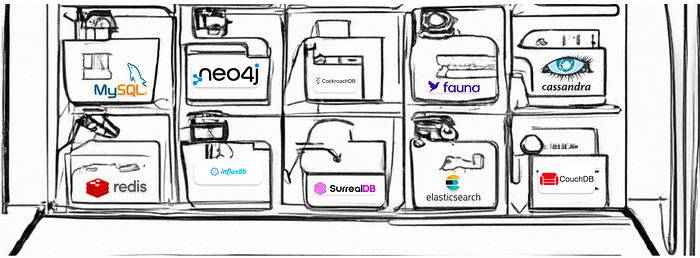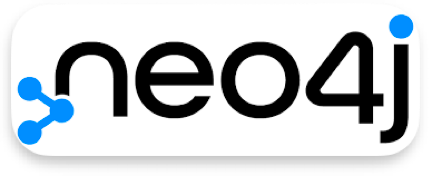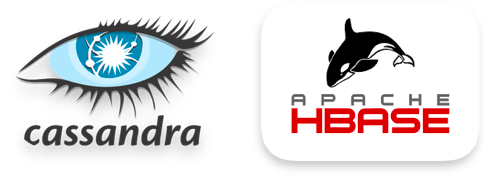Unleash the Power of Data: An Introduction to the 8 Types of Databases You Should Know
Welcome to the wild, wacky world of databases! Whether you’re a tech ninja or a newcomer 👩💻 to the digital world, you’ll find that these unsung heroes of the digital age are essential for keeping your data organised and secure. But with so many types of databases to choose from, how do you know which one is right for you?

Picture a toolbox filled with different tools, each designed for a specific task. That’s what databases are like — each type is designed to handle different types of data and meet different needs. In this guide, we’ll cover the eight most popular types of databases. So grab a hot cup of java ☕️ (or your favourite beverage 🥃), and let’s dive in!
1. Relational Databases
Relational databases are like a well-organized library 📚, where each book represents a record, each chapter represents a field, and each shelf represents a table.
These databases are the most common type used today and store data in a structured format using tables, rows, and columns. With the use of keys, relational databases can easily define relationships between data elements, making them ideal for structured data like customer information, financial transactions, and product inventory. Some of the most popular relational databases include Oracle, MySQL, and Microsoft SQL Server.

2. Document Databases
Document databases organize data in the form of documents instead of rows and columns. These databases are intended to accommodate unstructured data like texts, images, and videos.
They work similarly to a filing cabinet 🗄, with each document representing a file and each folder symbolizing a group of files.
Document databases are frequently utilized in e-commerce platforms and content management systems due to the complex nature of their data structure. Notable document databases include MongoDB and CouchDB.

3. Graph Databases
Graph databases operate similarly to a social network 🔗, where every individual is depicted as a node, the connections between them are represented as edges, and their personal information is stored as a record.
These databases prioritize the management of relationships between data elements, making them perfect for handling intricate connections such as those found in social networks, recommendation engines, and fraud detection systems. The most well-known graph database is Neo4j.

4. Search Databases
Search databases function similarly to a search engine 🔎, allowing you to retrieve relevant results from a vast amount of unstructured data by simply typing in a query.
Designed for full-text search and text analysis, search databases are perfect for providing quick and precise search capabilities in e-commerce websites and content management systems. Two examples of well-known search databases are Elasticsearch and Solr.

5. Wide Column Databases
Wide-column databases are the solution for big data and IoT applications that require handling vast amounts of data with high write loads.
Picture a spreadsheet , where each record is a row, each field is a column, and each table is a sheet.
That’s what wide-column databases are like, and they are making a big impact in the tech world. Apache Cassandra and HBase are two of the most widely used wide-column databases in the industry.

6. Key-Value Databases
Key-Value databases are like a giant dictionary 📖, where each word represents a key and each definition represents a value.
These databases are designed for fast data retrieval and are ideal for applications that require quick data access and low latency, such as caching, session management, and real-time analytics. Some popular key-value databases include Redis and Riak.

7. Time-Series Databases
Time-Series databases are like a chronicle of events, where each event is recorded along with a timestamp ⏲.
These databases are optimized for handling time-stamped data and are ideal for use cases like IoT and financial data analysis. InfluxDB and TimescaleDB are examples of popular time-series databases.

8. Multi-Model Databases
Multi-Model databases are like a versatile toolbox, capable of adapting to various challenges and serving multiple purposes.
These databases are designed to handle diverse data structures and are ideal for use cases where multiple data models are required, such as e-commerce platforms, content management systems, and customer relationship management systems. They are like a jack-of-all-trades, bringing together the best of different data models to provide a comprehensive solution. With a multi-model database, you no longer have to worry about switching between different tools to manage different types of data. Instead, you have everything you need in one handy toolbox, ready to tackle any task that comes your way. ArangoDB and OrientDB are examples of multi-model databases.

So, there you have it — the Eight Wonders of the Database World 🏛! Whether you’re building a new application, or looking to upgrade your current setup, understanding the different types of databases available will help you make an informed decision. Just like a handyman 👩🏭 always has the right tool for the job, you’ll have the right database for your needs.
Well, if you’re feeling overwhelmed by the choices, don’t panic — think of it like trying to choose your favourite flavour of ice cream 🍦. Just because one flavour is popular, doesn’t mean it’s the best fit for you. Take your time to consider your specific data needs, and then pick the right database type for the job. And don’t forget, there’s always room for more than one flavour in your ice cream cone. With multi-model databases, you can have the best of both worlds!
I hope this was a good introduction to the world of databases. Please let me know in the comments below what you think. Is there some type of database that I’ve missed? How did you make a choice for a database in your app?
